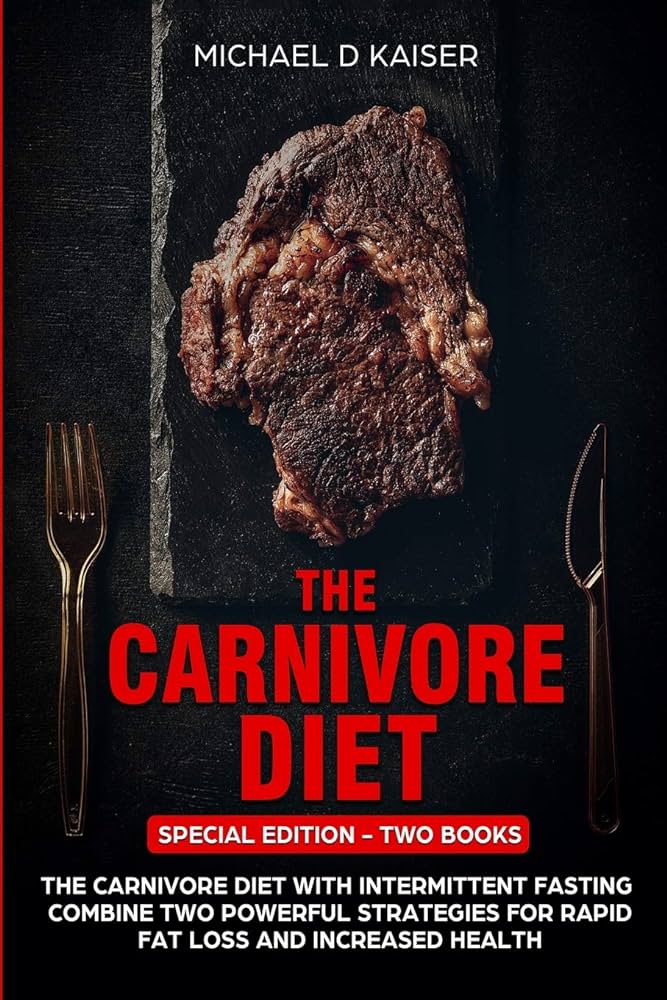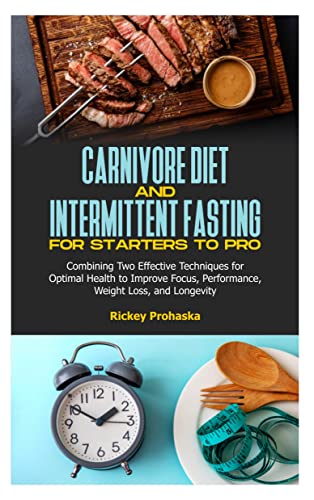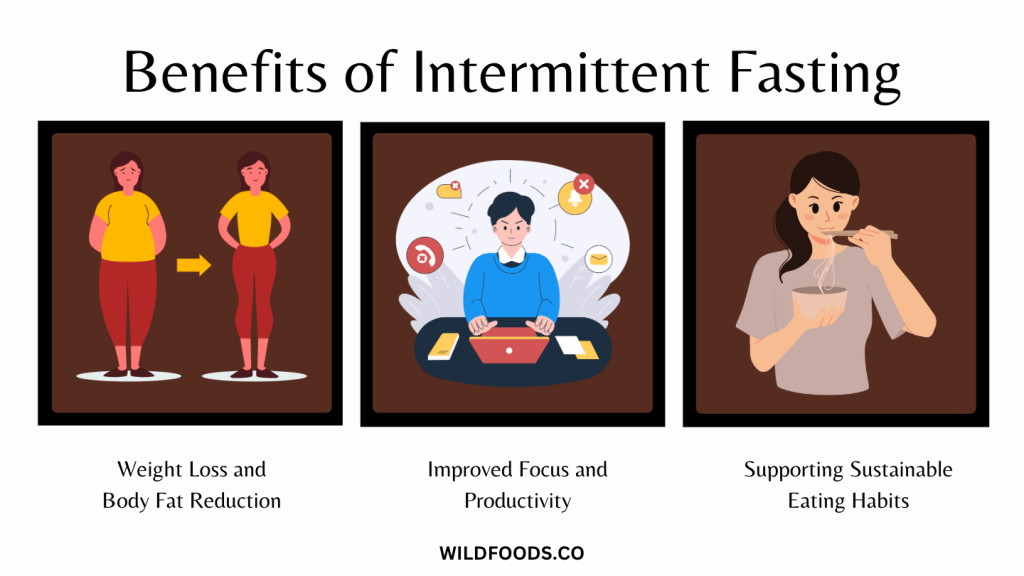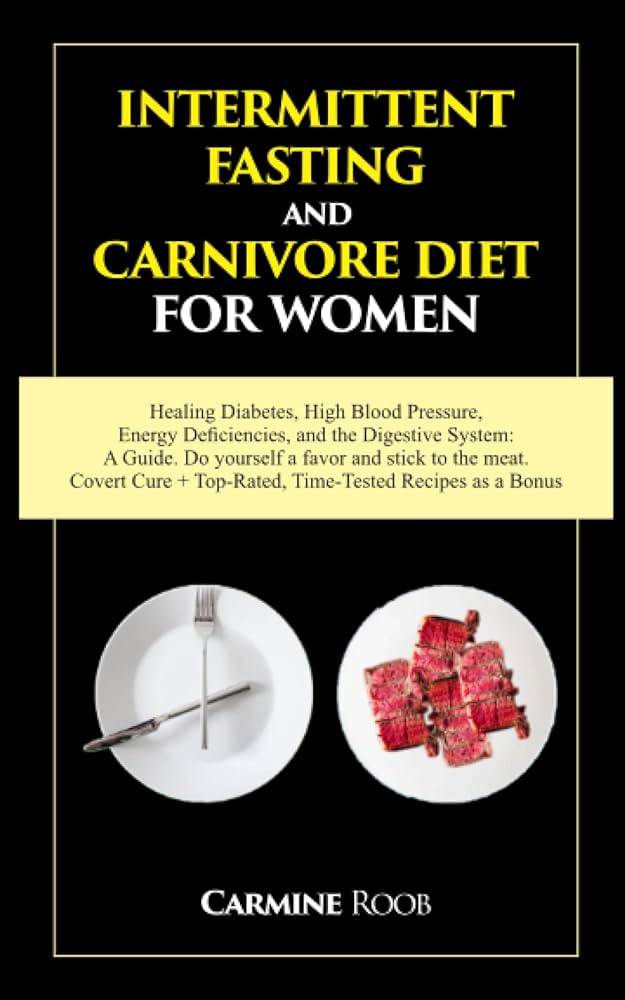Ready to embark on a journey towards optimal health and a more balanced lifestyle? Look no further, as we are about to introduce you to the world of intermittent fasting on the carnivore diet. In this article, you will discover the basics of this powerful dietary approach, which combines the principles of intermittent fasting with the nourishing benefits of a carnivorous eating pattern. So, grab your notepad and get ready to revolutionize your eating habits with the guidance and support you need to successfully incorporate this lifestyle change into your daily routine.

This image is property of Amazon.com.
Understanding Intermittent Fasting
What is intermittent fasting?
Intermittent fasting is a dietary approach that involves cycling between periods of fasting and eating. It focuses on when you eat rather than what you eat. Unlike traditional diets that restrict certain foods, intermittent fasting limits the time window for eating.
There are various ways to practice intermittent fasting, but the most common methods include the 16/8 method, where you fast for 16 hours and eat within an 8-hour eating window, and the 5:2 method, where you eat normally for five days and restrict calorie intake for two non-consecutive days.
Benefits of intermittent fasting
Intermittent fasting has gained popularity for its numerous potential health benefits. It can aid in weight loss by reducing calorie consumption and improving fat burning. Additionally, intermittent fasting may help regulate blood sugar levels, enhance insulin sensitivity, and promote autophagy, which is the body’s natural process of cellular repair.
Studies suggest that intermittent fasting may also have positive effects on brain health, improving cognitive function and reducing the risk of neurodegenerative diseases. Moreover, it may help lower inflammation, improve heart health, and even extend lifespan.
Different intermittent fasting methods
As mentioned earlier, there are several intermittent fasting methods to choose from. Apart from the 16/8 and 5:2 methods, there is also the alternate-day fasting, where you alternate between fasting days and normal eating days. Another popular approach is the 24-hour fast, where you fast for a full 24 hours once or twice a week.
It’s important to choose an intermittent fasting method that suits your lifestyle and goals. Experimenting with different methods can help you find a fasting schedule that feels sustainable and comfortable for you.
Introduction to the Carnivore Diet
What is the carnivore diet?
The carnivore diet, also known as the zero-carb diet, is a highly restrictive eating plan that primarily consists of animal-based foods. It involves consuming mainly meat, fish, and animal products while eliminating all plant-based foods, including fruits, vegetables, grains, and legumes.
Proponents of the carnivore diet argue that humans can thrive solely on animal-based foods, as our ancestors may have done. They claim that by excluding plant foods, which can contain anti-nutrients and potential allergens, the body can optimize digestion and absorption of nutrients.
Benefits of the carnivore diet
Advocates of the carnivore diet believe that it can improve various health markers, including weight loss, energy levels, mental clarity, and digestion. Since the diet eliminates carbohydrates and focuses solely on animal-based proteins and fats, it may lead to quick and significant weight loss. The high protein content can also help preserve muscle mass.
Some individuals with autoimmune conditions or digestive issues have reported improvements in their symptoms after adopting the carnivore diet. By eliminating potentially problematic plant foods, they claim to experience reduced inflammation, improved gut health, and better overall well-being.
Challenges and considerations
While the carnivore diet may have its benefits, it’s important to consider the potential challenges and limitations. The diet is highly restrictive and eliminates entire food groups, which can make it difficult to meet certain nutrient requirements. It may also pose challenges when dining out or socializing, as many meals and gatherings revolve around plant-based options.
Furthermore, the long-term sustainability of the carnivore diet remains a topic of debate. Since it is still relatively new and lacks comprehensive scientific research, it is crucial to approach the diet with caution and consider individual variations in nutrient needs.
Combining Intermittent Fasting and the Carnivore Diet
Why combine intermittent fasting and the carnivore diet?
Combining intermittent fasting and the carnivore diet can offer a synergistic effect towards achieving health goals. The two approaches complement each other, as intermittent fasting focuses on when to eat, while the carnivore diet dictates what to eat.
Intermittent fasting can help individuals on the carnivore diet optimize their metabolism and fat-burning capabilities. By extending the fasting window and allowing the body to fully enter a fasted state, it may enhance autophagy and promote more efficient cellular repair.
Potential benefits of combining both approaches
The combination of intermittent fasting and the carnivore diet may bring various benefits. With intermittent fasting, you can fine-tune your eating schedule and avoid mindless snacking or grazing throughout the day. This can help control calorie intake and potentially aid in weight loss.
Moreover, by incorporating intermittent fasting, individuals on the carnivore diet can tap into the potential cognitive and anti-inflammatory benefits associated with intermittent fasting. It may further support gut health, energy levels, and overall well-being.
Getting Started with Intermittent Fasting on the Carnivore Diet
Consulting with a healthcare professional
Before embarking on any dietary changes, it is essential to consult with a healthcare professional or registered dietitian. They can assess your individual health needs and provide personalized recommendations. This is particularly crucial when considering the restrictive nature of the carnivore diet and the potential impact of intermittent fasting on certain medical conditions or medications.
Choosing an intermittent fasting method
To get started with intermittent fasting on the carnivore diet, you need to choose an intermittent fasting method that aligns with your goals and lifestyle. As mentioned earlier, popular methods include the 16/8 method, 5:2 method, alternate-day fasting, and the 24-hour fast. Experiment with different approaches to find the one that suits you best.
Understanding your eating window
Once you have chosen an intermittent fasting method, it’s important to understand your eating window. This refers to the set period during which you can consume your meals. For example, with the 16/8 method, you might choose to eat between 12 pm and 8 pm, fasting for the remaining 16 hours.
Understanding your eating window allows you to plan your meals accordingly and ensure you consume adequate nutrients within the designated timeframe.
Planning your meals
When following the carnivore diet, meal planning becomes essential to ensure you meet your nutrient requirements. As your diet primarily consists of animal-based foods, it’s crucial to incorporate a variety of proteins, healthy fats, and organ meats to ensure balanced nutrition.
Plan your meals to include a variety of animal proteins like beef, pork, fish, and poultry, along with healthy fats like butter, ghee, and tallow. Organ meats, such as liver and kidney, can provide essential micronutrients. Ensure you consume an adequate amount of calories to support your energy needs.
Tracking your progress
Keeping track of your progress can be helpful during your intermittent fasting and carnivore diet journey. You can monitor changes in weight, energy levels, and other relevant health markers. Tracking can also provide insight into your eating patterns and help identify any potential adjustments needed for optimal results.
There are numerous smartphone apps and online tools available that make tracking your meals, fasting periods, and progress easy and convenient.

This image is property of Amazon.com.
Selecting the Right Foods for the Carnivore Diet
Emphasizing animal-based foods
As the carnivore diet strictly focuses on animal-based foods, it’s important to emphasize their inclusion in your meals. Opt for a variety of high-quality animal proteins, including lean cuts of beef, lamb, and poultry, as well as fatty fish like salmon and sardines. Eggs, bacon, and various cuts of pork can also be included.
Be aware that some animal-based products may contain added ingredients or be processed. For optimal results, prioritize whole-food sources and avoid processed meats or those with additives or artificial ingredients.
Choosing high-quality sources
To maximize the nutritional benefits of the carnivore diet, selecting high-quality sources of animal-based foods is crucial. Whenever possible, choose grass-fed, pasture-raised, or wild-caught options. These sources tend to offer higher nutrient content and fewer harmful substances like antibiotics or hormones.
If sourcing high-quality animal products becomes a challenge, consider exploring local farmers’ markets or connecting with local farmers who can provide you with the desired quality and variety.
Incorporating variety into your diet
While the carnivore diet may seem restrictive, it’s still important to incorporate variety within the scope of animal-based foods. Opt for different types of animal proteins, including beef, poultry, pork, and fish, to ensure a diverse array of nutrients. Experiment with different cuts, cooking methods, and seasonings to keep your meals interesting and enjoyable.
Including organ meats like liver and kidney can also provide essential micronutrients, such as vitamins A and B12. Don’t shy away from incorporating healthy fats, like grass-fed butter or olive oil, to add flavor and satiety to your meals.
Common Challenges and Solutions
Addressing hunger during fasting periods
One common challenge when starting intermittent fasting on the carnivore diet is dealing with hunger during fasting periods. While transitioning to fasting, it’s normal to experience hunger pangs as your body adapts to the new eating pattern.
To address hunger, ensure that your meals during the eating window are satisfying and provide adequate calories and nutrients. Including sufficient healthy fats can help promote satiety. Additionally, staying well-hydrated, consuming bone broth, or incorporating small snacks, like hard-boiled eggs or beef jerky, can help manage hunger during fasting periods.
Navigating social situations
Adopting a specific dietary approach can sometimes present challenges in social situations. When combining intermittent fasting and the carnivore diet, it’s important to communicate your dietary preferences and restrictions to friends, family, and colleagues in advance.
Offer to bring your own carnivore-friendly dish to gatherings or suggest restaurants that can accommodate your dietary needs. Remember that adhering to your eating window and food choices is ultimately your decision, and it’s essential to stay committed to your goals while still enjoying social interactions.
Potential nutrient deficiencies and how to address them
Since the carnivore diet eliminates plant-based foods, there is a risk of nutrient deficiencies if careful attention is not given to meal planning. Important nutrients that may be lacking on the carnivore diet include fiber, vitamin C, certain B vitamins, and certain minerals like magnesium and potassium.
To address potential nutrient deficiencies, consider incorporating organ meats, which are rich in various micronutrients. You may also supplement with a high-quality multivitamin or specific nutrients to ensure you meet your nutritional needs. Regular blood tests can help identify any deficiencies and guide your supplementation choices.
Managing potential digestive issues
Transitioning to the carnivore diet may cause digestive changes as your body adapts to the absence of fiber and plant-based foods. Some individuals may experience constipation, while others may notice changes in bowel movements. These changes are typically temporary but can be managed by staying well-hydrated, consuming adequate fats, and gradually increasing fat intake to improve digestion.
If digestive issues persist or become severe, it’s advisable to consult with a healthcare professional or registered dietitian for personalized guidance.

This image is property of Amazon.com.
Adjusting Intermittent Fasting and the Carnivore Diet to Fit Your Lifestyle
Adapting the eating window to your schedule
One of the advantages of intermittent fasting is its adaptability to different lifestyles. The eating window can be adjusted to accommodate individual schedules and preferences.
If you have morning commitments or prefer to have your meals earlier in the day, you can modify the eating window accordingly. For example, you might adopt a 14-hour fasting window from 6 pm to 8 am, allowing for an earlier breakfast.
Experiment with different eating windows to find what suits your lifestyle best and supports your goals.
Making modifications for exercise
Exercise is an important component of a healthy lifestyle. When combining intermittent fasting and the carnivore diet, it’s crucial to consider adjustments for exercise.
If you exercise during your fasting window, it’s important to stay properly hydrated and ensure you consume adequate nutrients within the eating window to support your physical activity. You can also experiment with timing your workouts before breaking your fast to replenish your body with nutrients post-exercise.
Individuals who engage in intense or prolonged exercise may benefit from adding a targeted pre- or post-workout meal to support performance and recovery. Consulting with a qualified exercise professional or registered dietitian can provide you with personalized guidelines based on your exercise routine.
Long-term sustainability and flexibility
While intermittent fasting and the carnivore diet can provide numerous benefits, it’s important to consider long-term sustainability and flexibility in your approach. Maintaining optimal health requires a balanced and varied diet.
Consider the carnivore diet and intermittent fasting as tools to achieve specific goals, rather than lifelong commitments. Incorporating occasional periods of balanced eating can help promote dietary flexibility, prevent nutrient deficiencies, and support overall well-being.
Precautions and Considerations
Potential risks and contraindications
While intermittent fasting and the carnivore diet can be beneficial for many individuals, they may not be suitable for everyone. Certain populations, such as pregnant or lactating women, individuals with specific medical conditions, or those with a history of disordered eating, should exercise caution or avoid these approaches altogether.
Always consult with a healthcare professional or registered dietitian before making significant changes to your diet or fasting routine, particularly if you have any underlying health conditions or are taking medications.
Monitoring your health
When following intermittent fasting on the carnivore diet, it’s important to monitor your overall health and well-being. Regular check-ups with your healthcare professional can help assess any potential concerns or changes in blood markers.
Additionally, pay attention to physical cues, such as changes in energy levels, digestion, or skin appearance. These indicators may help identify any imbalances or potential issues related to your diet or fasting routine.
Listening to your body
Ultimately, it’s essential to listen to your body’s signals and adjust your approach accordingly. While intermittent fasting and the carnivore diet have shown potential benefits, each individual is unique. Pay attention to how your body responds to the changes in eating patterns and adjust as needed.
If you experience any negative symptoms or severe reactions, it’s advisable to consult with a healthcare professional or registered dietitian for guidance tailored to your specific needs.

This image is property of cdn.shopify.com.
Sample Meal Plan for Intermittent Fasting on the Carnivore Diet
Breakfast options
- Scrambled eggs with bacon
- Omelette with ground beef and cheese
- Steak and eggs
- Salmon and cream cheese roll-ups
- Beef liver and onions
Lunch ideas
- Grilled chicken thighs with buttered broccoli
- Beef patty with avocado slices wrapped in lettuce leaves
- Tuna salad with mayonnaise and hard-boiled eggs
- Pork chops with sautéed kale
Dinner recipes
- Ribeye steak with grilled asparagus
- Lamb chops with cauliflower mash
- Roasted chicken drumsticks with Brussels sprouts
- Pan-seared salmon with lemon butter sauce
Snack suggestions
- Beef jerky or biltong
- Pork rinds
- Hard-boiled eggs
- Cheese cubes or slices
Remember to adjust portion sizes and timings based on your preferred intermittent fasting method and individual nutritional needs.
Tips for Staying Motivated and Overcoming Challenges
Setting realistic goals
When embarking on the combined journey of intermittent fasting and the carnivore diet, setting realistic goals is essential. Establish achievable targets for weight loss, improved energy levels, or overall well-being. Start with small milestones and celebrate your progress along the way.
Finding support and accountability
Seeking support and accountability can greatly enhance your success. Joining online communities or local groups of individuals following similar dietary approaches can provide motivation and a sense of community. Sharing experiences, recipes, and tips can help you navigate challenges and stay on track.
Additionally, consider finding an accountability partner, such as a friend or family member, who can support and encourage you on your journey. Having someone to share your experiences and successes with can make the process more enjoyable and sustainable.
Celebrating milestones
Don’t forget to celebrate your achievements along the way. Whether it’s reaching a weight loss goal, successfully completing a fasting period, or sticking to the carnivore diet for a certain period, take the time to acknowledge your efforts and reward yourself.
Celebrate with non-food-related rewards, such as a pampering session, a new workout outfit, or a day trip to a place you enjoy. Making the process enjoyable can help you stay motivated and continue on your path to optimal health.
Dealing with setbacks
Setbacks are a natural part of any journey, and it’s important to approach them with resilience and a positive mindset. If you encounter challenges or have a day where you deviate from your plan, don’t let it discourage you. Instead, use it as an opportunity to learn and grow.
Reflect on the factors that led to the setback and find strategies to overcome them in the future. Remember that every day is a new opportunity to make choices that align with your goals, and setbacks should not define your overall progress.
By incorporating intermittent fasting into the carnivore diet, you have the potential to experience numerous health benefits. However, it’s crucial to approach these dietary approaches with caution and adapt them to suit your individual needs. Always seek professional guidance, listen to your body, and make choices that support your long-term well-being. Happy fasting and carnivore eating!

This image is property of Amazon.com.